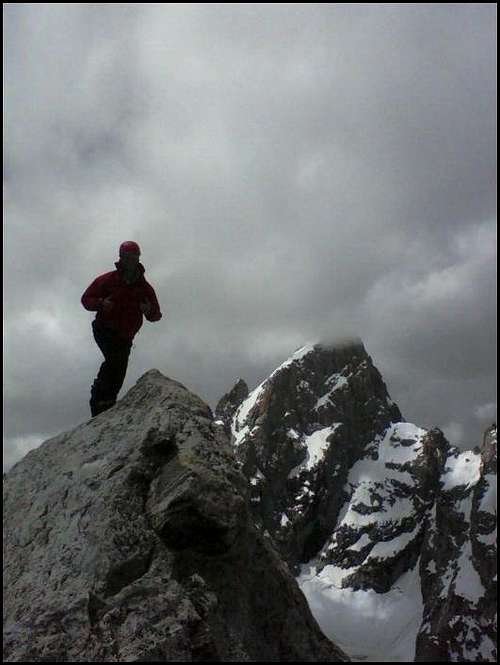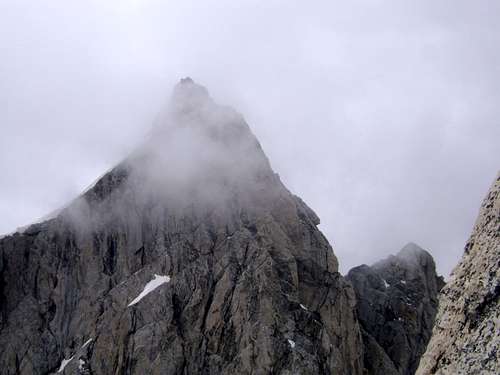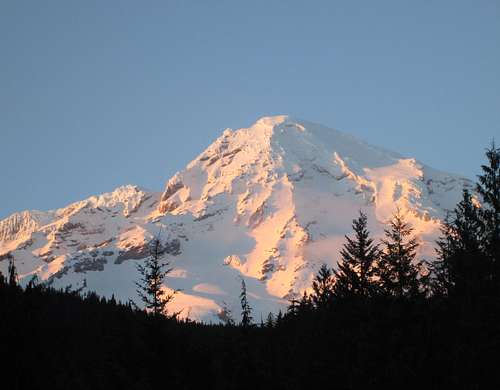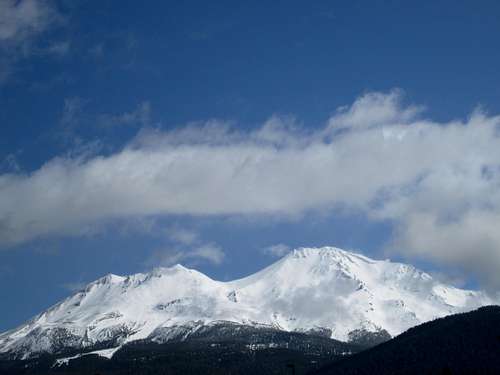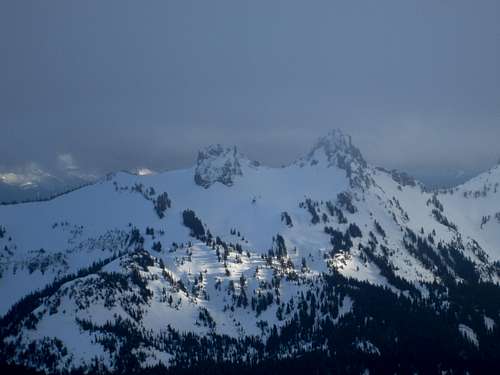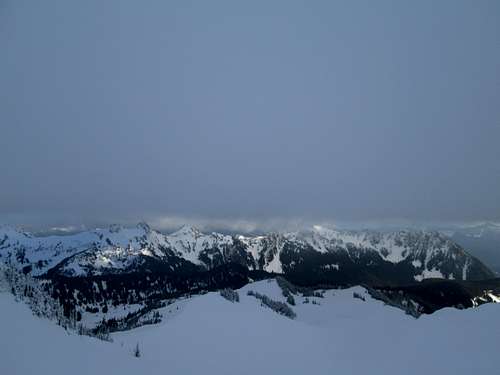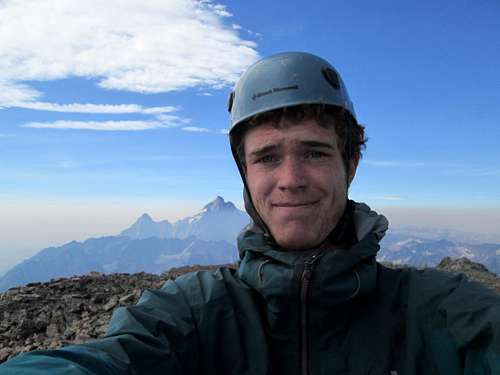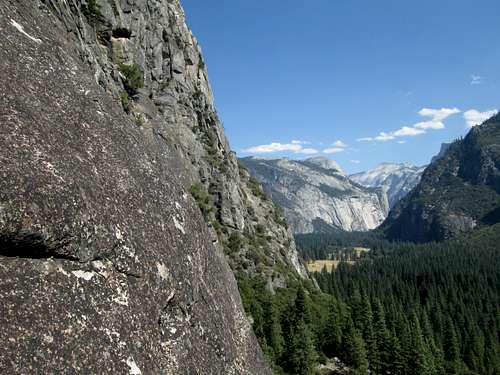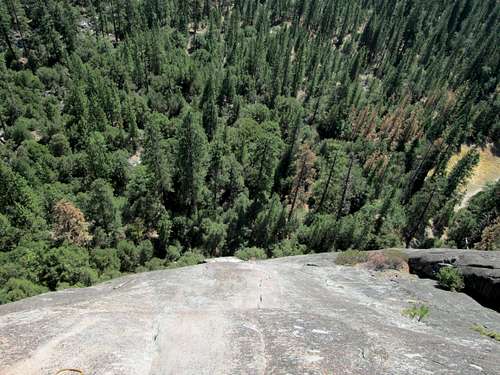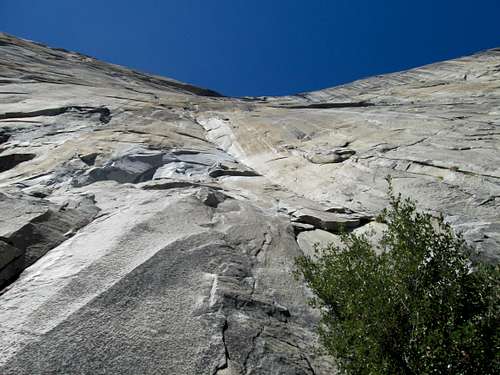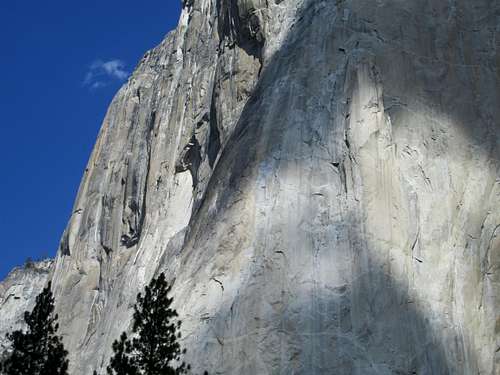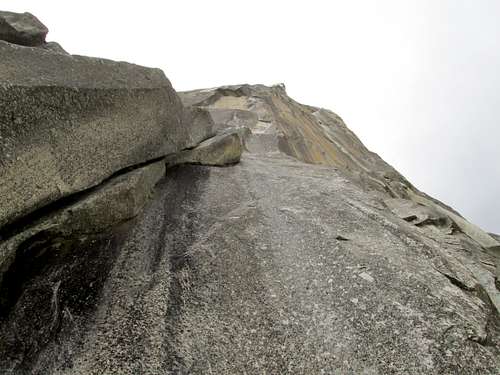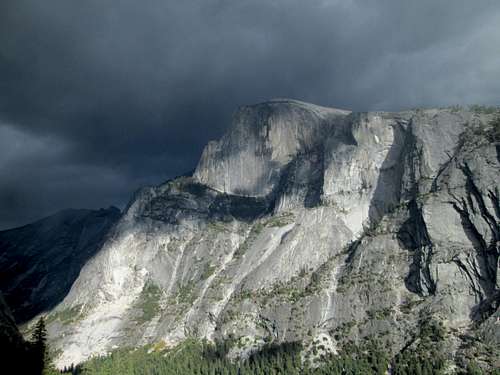Learning to accept defeat in the mountains
Before the year 2013, I had not truly tasted the agony of defeat in the mountains (with the exception of shattering my heel bone while bouldering, which required half a year of surgery and rehab, and still causes me lots of pain). Sure, there had been a couple of half cocked attempts on peaks that ended in retreat, most notably my failed attempt to solo the Grand Teton in a day(I started hiking at 6pm thinking I would summit overnight and beat the crowds on the descent. I ended up curled up in a ball, freezing my ass of in the Teton Glacier Morain, where I spent the night under a tattered "survival blanket". When the sun came out I staggered down the trail and ended up getting some strange looks from tourists who saw me sleeping in the middle of the trail.).
![The Middle Teton at night]() The Middle Teton seen at sunset on my failed solo attempt of the Grand Teton
The Middle Teton seen at sunset on my failed solo attempt of the Grand Teton ![The Devils Tower]() The Devils Tower, located in eastern Wyoming, was my first major trad climb.
The Devils Tower, located in eastern Wyoming, was my first major trad climb.
Still for the most part, myself and my climbing partner JD had been remarkably lucky in our ascents thus far. We had even made some summits in terrible weather and conditions, and began to feel as though we could do anything with enough determination(or stupidity). It was the beginning of both of our climbing careers, and we were drunk with the euphoria of repeated success. We even made it up Devils Tower, despite having a total of 5 cams and absolutely no crack climbing experience. We ran out of water about an hour into that climb, on a 100 degree day. The next summer we made successful ascents of the Petzoldt Ridge of the Grand Teton, as well as Mount Owen and Teewinot(in a particularly stupid early season climb) It was these inexplicable successes, in the face of our overwhelming lack of experience and knowledge, that began to foster a bit of an ego in me. I though that we were pretty hardcore, and could do just about any climb, provided we had the time and the money.
![JD on top of Teewinot during winter conditions]() JD on top of Teewinot after a foolhardy ascent a day after a snowstorm, which left the mountain covered in high angle snow, ice, wet rock, and occasional avalanches. I nearly slid to my death while descending a small cliff which required a left foot jam(my foot was still fresh out of surgery at the time).
JD on top of Teewinot after a foolhardy ascent a day after a snowstorm, which left the mountain covered in high angle snow, ice, wet rock, and occasional avalanches. I nearly slid to my death while descending a small cliff which required a left foot jam(my foot was still fresh out of surgery at the time).![The upper section of the west ridge of Crazy Peak]() The west ridge of Crazy Peak,which myself and several freinds climbed in blue jeans despite the stormy weather, snow and ice.
The west ridge of Crazy Peak,which myself and several freinds climbed in blue jeans despite the stormy weather, snow and ice.
![North Face/Ridge of the Grand Teton]() Nearing the summit of Mount Owen at nearly 5 PM with rain approaching. This ascent once again forced us to make an unplanned freezing overnight stay without sleeping bags.
Nearing the summit of Mount Owen at nearly 5 PM with rain approaching. This ascent once again forced us to make an unplanned freezing overnight stay without sleeping bags.
Fast foreward to the spring of 2013, and I am preparing for an interview with RMI, a guiding service on Mount Rainier, in the Washington Cascades. I studied quite hard for the interview, but did not end up getting accepted into the team. I was a bit confused and frustrated, but figured that it was just because of my relatively young age, and had nothing to do with my skills as a mountaineer. Following this interview, JD and I decided to spend the last of our summer earnings attempting a "tour de cascade". Our plan was to summit every major peak in the Cascade range, from Mount Shasta up to Mount Rainier. The fact that it was April, and the Cascades were covered in a constant cloud blanket did not deter us. We figured it would be a simple matter of stubborn determination, even if the conditions were horrible. Needless to say, we had no idea what we were getting into. After driving to Mount Shasta, we ended up camped in the national forest, covered in rain and snow, waiting for the weather to clear so that we could make a summit attempt. It just so happened that the period in which we were attempting to climb Shasta was one of hurricane force winds above 10,000 ft, accompanied by bitter, frostbite inducing cold. We waited for two weeks in the rain, during which time I got pneumonia, before we finally decided to try our luck on another peak. By this point we had spent nearly all of our money, and so instead of hitting up all of the major Cascades to our north, we headed straight for Mount Rainier, which we had succesfuly climbed two years earlier.
![Mount Rainier seen from Longmire at sunset.]() Mount Rainier seen from Longmire at sunset, on my failed trip to interview for a guide position with RMI.
Mount Rainier seen from Longmire at sunset, on my failed trip to interview for a guide position with RMI.![Mount Shasta and Shastina seen from the West, April 2013]() Mount Shasta and Shastina seen from the West, April 2013. The weather stayed horrible for the entire two week we were there. There were hurricane force winds ripping across the upper sections of the mountain.
Mount Shasta and Shastina seen from the West, April 2013. The weather stayed horrible for the entire two week we were there. There were hurricane force winds ripping across the upper sections of the mountain.
Of course at this point our egos were still slightly intact, and so we decided we would climb the Liberty Ridge(one of the hardest and most dangerous routes on Rainier, even during peak season). Upon arriving at the Ranger Station in Longmire, we were informed that the Disappointment Cleaver was our only option, and we had a one day weather window to make it to the summit and back. We were a bit disappointed due to the fact the this was the same route we had climbed before, but the prospect of climbing Rainier again was still very exciting. At the time, we were the only people attempting to climb the mountain(which is normally packed to the gills with crowds). We set out that afternoon hoping to reach Camp Muir before dark. However, after ascending a couple thousand feet we found ourselves in a complete whiteout. The air temperature was beginning to plummet, and disorientation was setting in. Rocks that looked to be several hundred feet away were in fact very close by, and I kept "seeing" the final slope to Camp Muir only to realize it was just a small rise. We trudged on in these conditions for quite sometime before taking a break to assess the situation. It was now so cold that all our food was frozen solid, and both JD and I had icicles hanging from our scant facial hair. JD wanted to turn back, a smart decision at this point, due to the fact that we had no idea how close we were to Camp Muir. I kept insisting that the clouds would break soon, if we just waited a little longer, but they never did. Little sucker holes would appear, and I would jump for joy, only to be crushed with disappointment when they vanished. After a while of this, I reluctantly decided that we would indeed have to retreat. That hike down was not fun. I had wasted all of my money on this trip and had not even come close to summiting one of our many goals. When we finally emerged beneath the cloud deck, I dejectedly stared at the mountain, wishing we had stayed up there and continued on(which would very likely have resulted in our deaths). We spent the night in Ashford getting drunk off of cheap tequila, lamenting our failures over the last month. I was particularly distraught; having failed to get a job with RMI just a month previously.
![Pinnacle Peak, Tatoosh Range, seen from Mount Rainier on the descent from Camp Muir]() Pinnacle Peak, Tatoosh Range, seen from Mount Rainier on the descent from Camp Muir, after a failed attemt to climb the Disappointment Cleaver Route.
Pinnacle Peak, Tatoosh Range, seen from Mount Rainier on the descent from Camp Muir, after a failed attemt to climb the Disappointment Cleaver Route.![The Tatoosh Range seen from Mount Rainier, on the descent from Camp Muir]() The Tatoosh Range seen from Mount Rainier, on the descent from Camp Muir just as we exited the cloud deck
The Tatoosh Range seen from Mount Rainier, on the descent from Camp Muir just as we exited the cloud deck
That summer, I got a job working as a server in a concessionaire at Grand Teton National Park. While I found practically no one to climb with(people were more interested in partying than mountaineering), I managed to accomplish several solo ascents and was able to guide a few freinds from work up the Upper Exum Ridge of the Grand Teton. I ended up soloing the CMC route on Mount Moran later that summer, and was begining to get my confidence back. After the summer jobs ended, myself and JD decided to head to Yosemite to try our hand at the big walls.
![The Grand Teton seen from the summit of Disappointment Peak, June 9, 2013]() The Grand Teton seen from the summit of Disappointment Peak, June 9, 2013, on a solo ascent I did of the Southeast Ridge
The Grand Teton seen from the summit of Disappointment Peak, June 9, 2013, on a solo ascent I did of the Southeast Ridge![The Grand Teton seen from the summit of Nez Perce, with stormy weather approaching]() The Grand Teton seen from the summit of Nez Perce, with stormy weather approaching
The Grand Teton seen from the summit of Nez Perce, with stormy weather approaching
![Myself and my friends Naomi and Nadine on the summit of the Grand Teton]() Myself and my friends Naomi and Nadine on the summit of the Grand Teton, summer 2013
Myself and my friends Naomi and Nadine on the summit of the Grand Teton, summer 2013![Myself alone on the summit of Mount Moran, August 19, 2013]() Myself alone on the summit of Mount Moran, August 19, 2013. It was quite an strange experience being by myself up so high.
Myself alone on the summit of Mount Moran, August 19, 2013. It was quite an strange experience being by myself up so high.
Upon arriving in Yosemite we could not find anywhere to camp, so we made do with more "natural" options. Upon returning to the spot where JD had parked his van, we found that it had been towed by the Yosemite Rangers, who made us pay a $100 dollar fine for a dirty car, plus a $200 dollar towing fee. Things were not off to a great start. We finally managed to secure a site a Camp 4(Which we later lost because we were a day late in renewing our site. We ended up staying in four different sites around Camp 4 during our one month stay). Right away the climbing in Yosemite was harder than I expected. I had spent the summer scrambling up low 5th class peaks in the Tetons and figured I was in good climbing shape. I figured wrong. Even 5.8s proved terrifying and very difficult for the first few weeks we were there.
![Looking down the valley from the belay on pitch 5 of Nutcracker, Yosemite National Park]() Looking down the valley from the belay on pitch 5 of Nutcracker, a 5.8 which proved to be quite an adventure.
Looking down the valley from the belay on pitch 5 of Nutcracker, a 5.8 which proved to be quite an adventure.![Looking down from the top of pitch 4 on Nutcracker, Manure Pile Buttress, Yosemite National Park]() Looking down from the top of pitch 4 on Nutcracker, during one of our "warmup climbs". I was thouroughly out of climbing shape.
Looking down from the top of pitch 4 on Nutcracker, during one of our "warmup climbs". I was thouroughly out of climbing shape.
Our plan was to start aid climbing up the big walls, first with the Washingon Column, then the Leaning Tower, and finally(this was a pipe dream) the Nose of El Capitain. During my first aid lead on the 1st pitch of Pacific Ocean Wall, at the base of El Cap, I took a terrifying 50 foot fall, and nearly landed on the deck. At camp 4 we had run into some fellows from the UK who had just climbed Lurking Fear, a difficult route on the massive monolith of El Capitain. They had encouraged us to backclean as much as possible to save gear for longer pitches. I took this advice to heart on my first aid lead, and backcleaned at least half of my gear. I was in the process of bounce-testing a Camelot Yellow C3(I had another placed beneath me in case this one blew), when I heard a sharp "PING"! Suddenly I was falling back first, watching the walls soar past me. It felt like I was in the air for several seconds(though it was probably less than that), during which time I was sure that all my gear had blown and I was about to be smashed to death or severely maimed. I shut my eyes and tensed my muscles for the tremendous impact. Suddenly I was jerked up by the rope and smacked against a tree probably no more than 15 feet off the ground. "Jackson!!Holy Shit Man!!!!!" JD exclaimed. I swore profusely while I was lowered down to terra firma. It turned out that a single red C4 had arrested my fall, and probably saved my life. It took me several days to recover from the shock of that incident. Luckily I was completely unhurt.
![The 1st pitch of Pacific Ocean Wall on El Capitan, Yosemite National Park]() The 1st pitch of Pacific Ocean Wall on El Capitan, where I took a huge lead fall. I fell from the top of the barely visible aid crack(in the upper center of the photo) near the top of the pitch, to beneath the top of the tree in the bottom of the picture
The 1st pitch of Pacific Ocean Wall on El Capitan, where I took a huge lead fall. I fell from the top of the barely visible aid crack(in the upper center of the photo) near the top of the pitch, to beneath the top of the tree in the bottom of the picture![The massive monolith of El Capitan, Yosemite National Park]() The massive monolith of El Capitan, where we trained for aid climbing at the base. El Cap is a truly intimidating piece of rock, and the though of being suspended near the top looking down seems quite terrifying.
The massive monolith of El Capitan, where we trained for aid climbing at the base. El Cap is a truly intimidating piece of rock, and the though of being suspended near the top looking down seems quite terrifying.
Finally after weeks of training and climbing with other residents of Camp 4, we decided it was time to try our hand at a big wall. The South Face of the Washington Column was our objective, and we planned to do it in two days. On our first try we packed our water at the bottom of the haul bag, causing the jugs to burst, aborting our attempt for the day. The next day we were ready, starving for a major accomplishment. We made quick progress up the South Face until we reached the Dinner Ledge, which was our planned camp spot for the night. The wind had picked up and black clouds were begining to form across the horizon. The weather forecast had called for sunny skies that day! We looked up and saw several climbers rappelling down. When they reached us it had begun to snow, and the sky was very dark. We all reluctantly decided that it would be better to bail than be caught in a severe storm, suspended on a big wall. When we reached the bottom, the clouds began to clear, and a beautiful rainbow stretched across the face of Half Dome. Damn! Foiled again by what we were now refering to as the malevolent "Spirit of Yosemite", which was the name of the movie in the park visitor centre. Several days later, the government shut down, and everyone was forced out of Yosemite. Our dreams of big walls would have to wait for another time. We decided to keep climbing, and headed out to Utah with some Norwegians we had met in Camp 4. Our plan was to do some crack climbing at a place called "Indian Creek". It was here where the last reminants of my climbing ego were utterly destroyed.
![Looking up from pitch 2 of the South Face of Washington Column]() Looking up from pitch 2 of the South Face of Washington Column, just as the storm clouds were beginning to roll in.
Looking up from pitch 2 of the South Face of Washington Column, just as the storm clouds were beginning to roll in.![Half Dome seen from partway up the South Face of the Washington Column, with storm clouds approaching]() Half Dome seen from partway up the South Face of the Washington Column, with storm clouds approaching
Half Dome seen from partway up the South Face of the Washington Column, with storm clouds approaching
Upon arriving at Indian Creek, we were introduced to the Windgate Sandstone, which is know for producing some of the most perfect crack systems on earth. The easiest climbs at Indian Creek tended to be around the 5.9+ range, with the vast majority being in the 5.10-5.12 range. This type of crack climbing requires skill with a technique known as jamming, which involves "jamming" you hands, fists, fingers, feet, toes, knees, legs, torso, and occasionally your head into the crack in lue of actual hand holds. My first attempt to climb one of these cracks the correct way resulted in a lot of cursing and hangdoging. So I just decided to cheat and layback the entire thing. Well that worked on about one climb, and I was soon forced to "jam" my way up the difficult cracks. Because I was not in as good of climbing shape as my partners, I led a total of 2 climbs at Indian Creek, Binjous Crack, and the South Six Shooter(a relatively easy peak located apart from the main sandstone bluffs). While I did manage to make it up all of the climbs we attempted, I was forced to hang every few seconds, and was embarassed to see my freinds send these routes with little to no difficulty. We spent a month in Indian Creek, during which time I improved quite a bit as a crack climber. However my former self image as a "badass" was forever lost. I now realize that I am a quite ameature climber, and will have to work very hard if I ever want to climb El Capitan or send 5.11s at Indian Creek. Thats ok though, because I love climbing primarily for the experience and adventure, the comradarie, and the voyage into the unknown. Thanks for reading!
![JD nearing the top of Unamed 5.10 on the left side of Blue Gramma Cliff, Indian Creek]() JD nearing the top of Unamed 5.10 at Blue Gramma Cliff, Indian Creek
JD nearing the top of Unamed 5.10 at Blue Gramma Cliff, Indian Creek![Johnny nearing the top of Chocolate Corner, 5.9+, Indian Creek]() Johnny nearing the top of Chocolate Corner, 5.9+, Indian Creek
Johnny nearing the top of Chocolate Corner, 5.9+, Indian Creek
![The South Six Shooter seen from the approach]() The South Six Shooter seen from the approach
The South Six Shooter seen from the approach![View towards canyonlands from the base of the South Six Shooter]() View towards canyonlands from the base of the South Six Shooter
View towards canyonlands from the base of the South Six Shooter
Comments
No comments posted yet.
